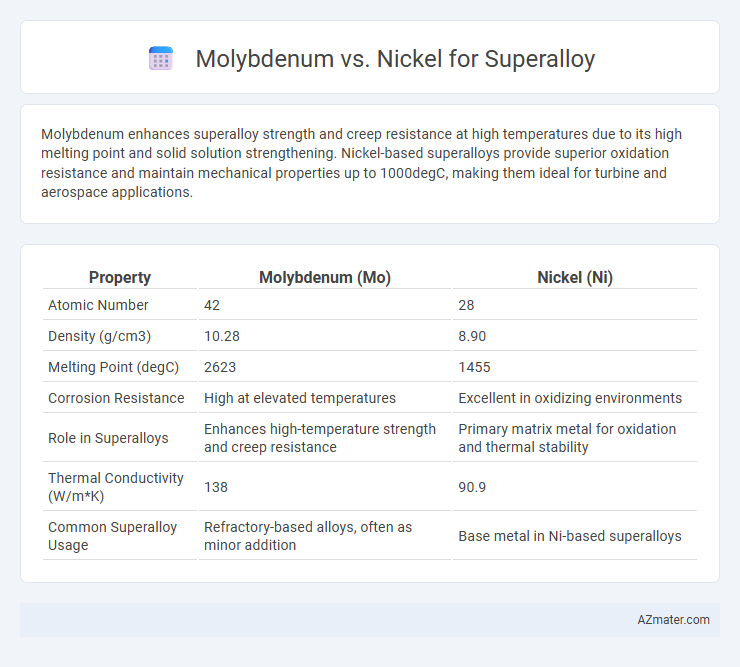Molybdenum enhances superalloy strength and creep resistance at high temperatures due to its high melting point and solid solution strengthening. Nickel-based superalloys provide superior oxidation resistance and maintain mechanical properties up to 1000degC, making them ideal for turbine and aerospace applications.
Table of Comparison
| Property | Molybdenum (Mo) | Nickel (Ni) |
|---|---|---|
| Atomic Number | 42 | 28 |
| Density (g/cm3) | 10.28 | 8.90 |
| Melting Point (degC) | 2623 | 1455 |
| Corrosion Resistance | High at elevated temperatures | Excellent in oxidizing environments |
| Role in Superalloys | Enhances high-temperature strength and creep resistance | Primary matrix metal for oxidation and thermal stability |
| Thermal Conductivity (W/m*K) | 138 | 90.9 |
| Common Superalloy Usage | Refractory-based alloys, often as minor addition | Base metal in Ni-based superalloys |
Introduction to Superalloys
Superalloys are advanced high-performance alloys designed for extreme environments such as aerospace engines and gas turbines, with exceptional strength and corrosion resistance at elevated temperatures. Molybdenum, valued for its high melting point and creep resistance, enhances superalloys' structural stability and thermal resilience. Nickel-based superalloys dominate the industry due to nickel's superior oxidation resistance and ability to form a stable matrix that supports high-temperature strength and fatigue resistance.
Key Properties of Molybdenum
Molybdenum exhibits exceptional high-temperature strength, excellent thermal conductivity, and superior resistance to creep and corrosion, making it a critical element in superalloy compositions. Its ability to maintain structural integrity under extreme thermal and mechanical stress enhances the performance of superalloys used in aerospace and power generation turbines. Compared to nickel, molybdenum significantly improves oxidation resistance and stabilizes the alloy microstructure at temperatures exceeding 1000degC.
Key Properties of Nickel
Nickel is a critical element in superalloys due to its excellent high-temperature strength, corrosion resistance, and oxidation resistance, making it ideal for turbine blades and jet engines. Its face-centered cubic (FCC) crystal structure provides superior ductility and toughness compared to molybdenum's body-centered cubic (BCC) structure. Nickel-based superalloys maintain mechanical stability at temperatures exceeding 1000degC, outperforming molybdenum alloys in environments requiring both strength and longevity.
Molybdenum vs Nickel: Mechanical Strength
Molybdenum exhibits higher mechanical strength and creep resistance at elevated temperatures compared to nickel, making it crucial for superalloys used in extreme environments like jet engines. Nickel provides excellent toughness and corrosion resistance but tends to soften under prolonged high-temperature exposure, limiting its mechanical strength. The combination of molybdenum's solid solution strengthening and nickel's ductility in superalloy matrices results in optimized mechanical performance for aerospace and power generation applications.
Corrosion Resistance Comparison
Molybdenum exhibits superior corrosion resistance in superalloys under high-temperature and oxidative environments due to its ability to form stable and protective oxide layers. Nickel-based superalloys offer excellent corrosion resistance in acidic and chloride-containing atmospheres, primarily attributed to the formation of a robust nickel oxide scale. The selective addition of molybdenum enhances localized corrosion resistance in nickel superalloys, improving performance in aggressive environments such as marine or chemical processing applications.
High-Temperature Performance
Molybdenum exhibits superior high-temperature strength and oxidation resistance in superalloys compared to nickel, making it ideal for applications requiring prolonged exposure to extreme heat. Nickel-based superalloys, however, offer excellent creep resistance and phase stability at elevated temperatures, crucial for turbine blades and aerospace components. Both metals contribute distinct thermal properties, with molybdenum enhancing melting point and thermal conductivity, while nickel improves overall corrosion resistance and mechanical stability under high-temperature stress.
Cost and Availability
Molybdenum offers a relatively lower cost and more stable availability compared to nickel, which is subject to higher price volatility due to limited global reserves and geopolitical factors. Nickel's critical role in superalloys enhances high-temperature strength and corrosion resistance but comes with premium costs and supply uncertainties impacting production. Manufacturers often balance molybdenum's economic advantage against nickel's superior performance depending on application requirements and market conditions.
Applications in Industry
Molybdenum's high melting point and excellent corrosion resistance make it essential in superalloys for aerospace gas turbines and nuclear reactors, where mechanical strength at elevated temperatures is critical. Nickel-based superalloys dominate in jet engines and power plant turbines due to their superior oxidation resistance and fatigue strength under cyclic thermal stress. Industries rely on Molybdenum for structural components exposed to extreme environments, while Nickel's versatility supports applications demanding both high-temperature performance and resistance to thermal creep.
Environmental Impact and Sustainability
Molybdenum exhibits greater environmental benefits compared to nickel due to its higher recyclability and lower toxicity during extraction and processing. The mining and refining of nickel often result in significant greenhouse gas emissions and soil contamination, whereas molybdenum's lifecycle tends to have reduced ecological footprints. Emphasizing molybdenum in superalloy production enhances sustainability by minimizing harmful waste and improving resource efficiency in high-temperature applications.
Choosing Between Molybdenum and Nickel for Superalloys
Choosing between molybdenum and nickel for superalloys depends on operating temperature and mechanical properties requirements. Molybdenum offers exceptional high-temperature strength and creep resistance, making it ideal for applications exceeding 1200degC, while nickel provides better oxidation resistance and toughness at intermediate temperatures around 700-1000degC. Nickel-based superalloys are often preferred in aerospace engines due to their corrosion resistance and fatigue strength, whereas molybdenum alloys excel in ultra-high-temperature environments found in power generation and nuclear reactors.

Infographic: Molybdenum vs Nickel for Superalloy
 azmater.com
azmater.com